Lawn grubs, often also known as white grubs, are the larvae of numerous beetles such as May, Masked chafers, Japanese beetles, June bugs, and other species. Before metamorphosing into adults, these larvae feed on grass roots and can cause extensive damage to a lawn. This is especially a problem when their population increases, particularly in the latter part of the summer. As the larvae feed, the grass cannot keep up and regrow roots rapidly enough to feed the hungry larvae. When this occurs, it is when you need to treat the grub infestation and get rid of these nasty bugs. In this article, let’s talk about the best grub killer.
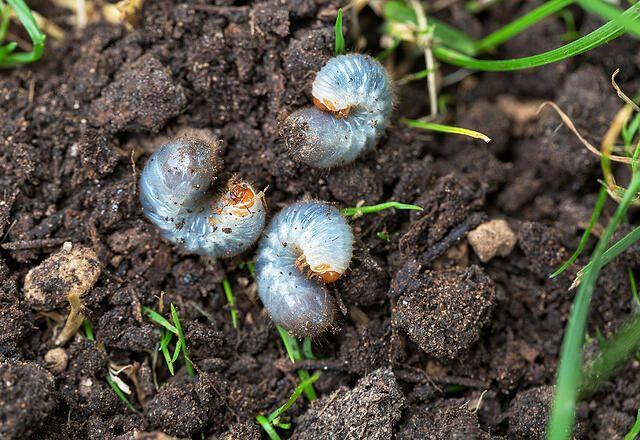
Grub damage may appear in home lawns from mid-September to November or from March to early May.
First, Make Sure The Problem Is Grubs!
Before taking action, it is essential to establish beyond a reasonable doubt that the issue in your yard is grubs. So, if you find a dead patch of grass, dig up a few Frisbee-size samples of grass surrounding the barren place to a depth of 2 inches with a shovel and have a look. It is also vital to realize that good grass, supported by periodic rainfall or irrigation, can sustain a grub density of two to three grubs per sq. ft. without any visible or significant damage to the turf. Furthermore, finding one or two grubs in your grass does not necessitate using a grub control product. So, do not rush!
When To Use A Grub Control Product?
If you are sure that you have an extensive grub problem, treatment becomes necessary, or grub worms will cause significant damage to the point that your lawn will require extensive renovation and repair. First, however, it is essential to be aware of the difference between insecticides that will kill grubs (also known as “reactive” or “curative” products) and those that will help prevent grub damage (also known as “proactively”).
Best Grub Control Products
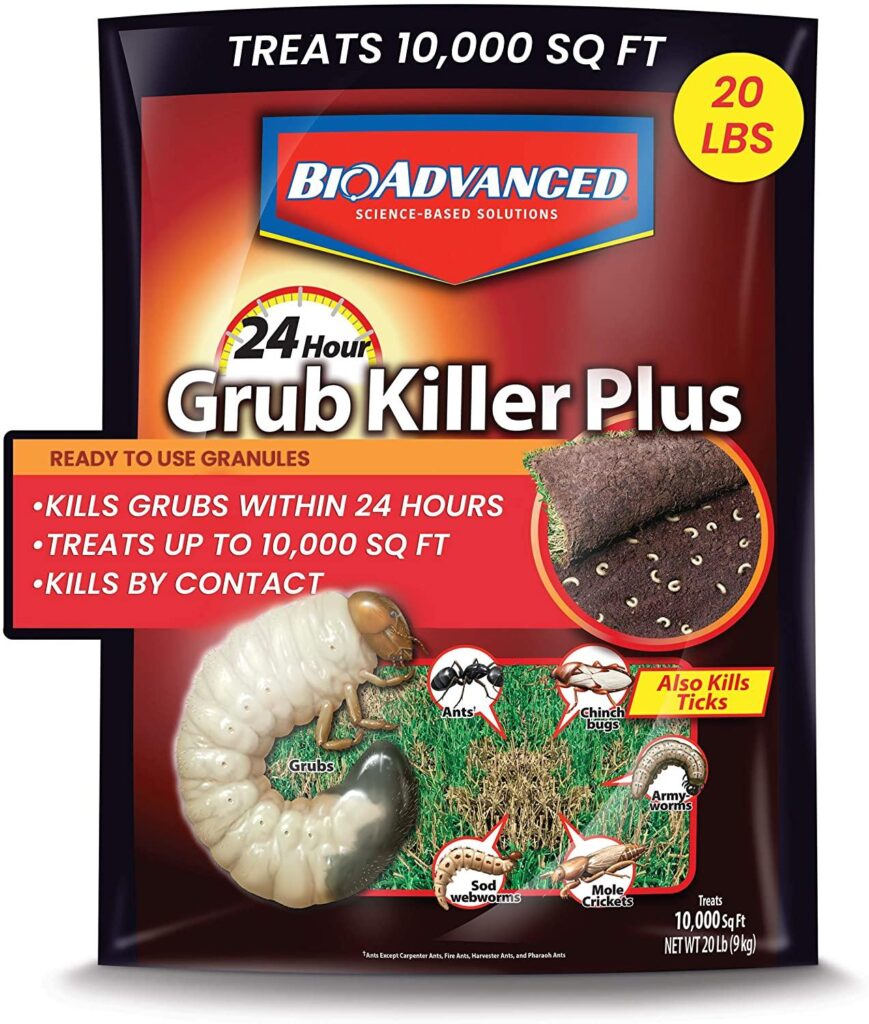
Delivers overnight results by killing grubs in 24 hours.
Following is a list of highly praised insecticides known for effectively controlling lawn grubs.
Best For The Money: Scotts Grubex1 Season Long Grub Killer
Best Overall: Bio-Advanced Granules 24-Hour Grub Killer
Also Consider: Bayer Crop Science Complete Insect Killer
Bayer Dylox 6.2 Granular White Grub Insecticide
Sevin Concentrate Pest Control
Best All-Season: Bayer Cropscience Season-Long Grub Control
Best Broad-Spectrum: Bonide – Insect & Grub Control
Most Eco-Friendly: Bug Sales Beneficial Nematodes
Best Rapid Action: Ortho Bug-clear Insect Killer
Best Preventative: St. Gabriel Organics Milky Spore Powder
We will now discuss these products in more detail and examine their pros, cons, and best use scenario. However, before that, let’s take a quick look at a few things that need to be considered before choosing a suitable grub control product.
Things To Look For When Buying A Grub Control
A single grub control is not suitable and cannot be used in each and every scenario. Even though the most efficient grub killer is slow-acting, an active infestation necessitates immediate intervention to avoid extensive damage to the lawn. For instance, grub control granules are often easier to use than liquids. However, liquid products, on the other hand, are superior for providing results more quickly. Continue reading to find out about some more important factors to think about before making a decision.
Organic Vs. Synthetic
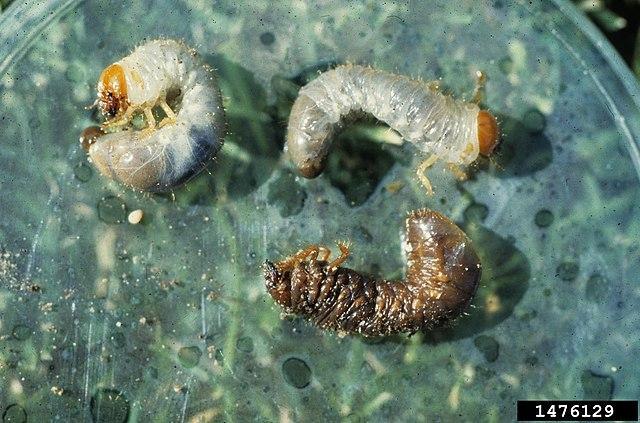
White grub larvae killed by milky spore disease lying next to healthy larvae.
Rapid results can be achieved with synthetic grub control treatments. Many synthetic products provide protection against white or lawn grubs for the entire season, which often lasts between three and four months. However, the majority of these grub control products also kill a wide variety of larva species in addition to the white grubs because of their low selectivity for lawn grubs. Nevertheless, synthetic products are still an excellent option for putting a quick end to grub problems. However, it is highly recommended that they be used exclusively in the areas that are affected by lawn grubs.
On the other hand, organic grub control products are incredibly successful in getting rid of grub infestations while also being entirely harmless for people, pets, and other beneficial insects. Milky spore disease and helpful nematodes are two examples of such organic grub killers that you can use. Both of these products make use of biological predators to eliminate grubs from the soil. Additionally, the effect of using them lasts for many years. However, they are ineffective against active infestations because of their slow working speed.
Liquid Vs. Granular
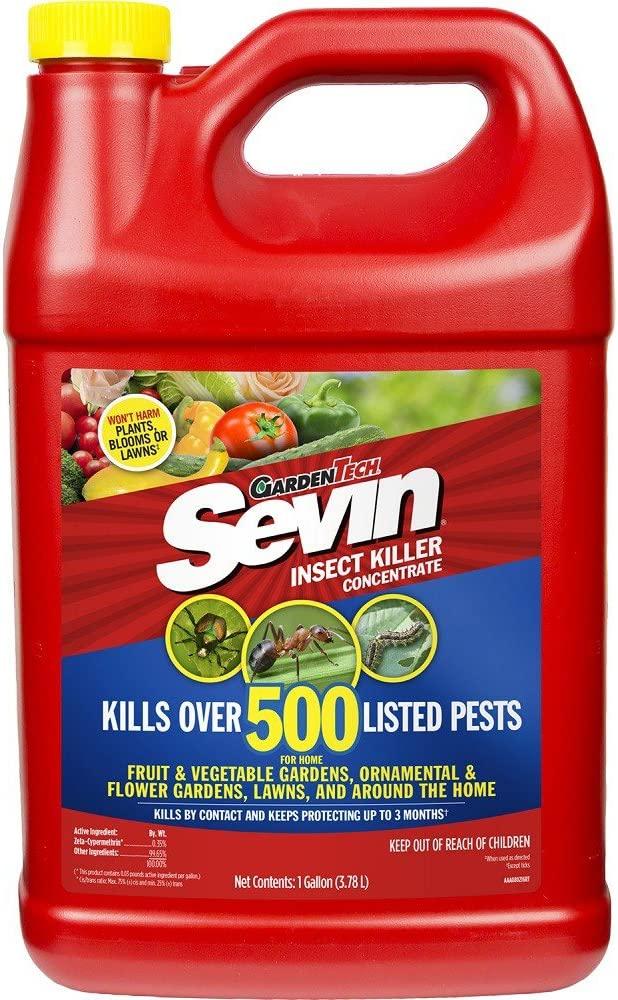
Liquid grub control products are quicker in action than granular grub control products.
Grub killers in the form of granules can be easily spread across a lawn using a spreader. When you are finished applying the granules, simply place any leftover granules back into the original bag. It is vital to keep in mind that the best application time for this treatment is right before it is about to rain, as this allows the active compounds to penetrate further and more deeply into the ground. However, if there is no rain, you will be required to water the grass after the application has been made.
On the other hand, liquid treatments are not only efficient but also quick when it comes to treating grub infestations. You only need to apply the treatment by spraying it onto the grass, and then you’re done. However, determining the rate of coverage can be challenging, and liquid spills are worse and more difficult to clean. In addition, you might also need to first dilute some liquid products with water before use.
Application

Prevent pets and children from entering the grub control treated area until the product has dried.
If you are using a liquid product, put on some rubber gloves and boots before the application and make sure to wash off any residue that remains afterward. Avoid applying the grub control product in windy conditions to keep treatments on target and reduce spray drift. Follow all the directions provided by the manufacturer regarding the application rate and amount of time that should pass between applications. In addition, mix the liquid concentrates in accordance with the dilution rate that has been provided.
Safety

Always store chemicals away from children and pets in their original containers.
Always make sure to read the instructions provided by the manufacturer before combining and applying any type of insecticide, whether it is organic or synthetic. Products that are dry may be dusty. Pour in a location that has adequate ventilation, and make sure you’re wearing a mask, so you don’t breathe in any dust. When mixing and handling liquids, it is essential to use protective clothing such as gloves, eye protection, long sleeves, and shoes with closed toes. In addition, it is critical to avoid both splashing and spilling liquids.
Best Grub Control Products | Review
Many of the greatest grub worm treatments I’ve used over the years contain bifenthrin, carbaryl, or Imidacloprid as the active ingredient. Having said that, the following insecticides are well regarded for their ability to control lawn grubs.
Scotts GrubEx1 Season Long Grub Killer

Scotts GrubEx is registered by the EPA to be used only once per year.
Product Specs
Coverage Area: 10,000 sq. ft. Form: Granules
Organic: No Quantity: 28 pounds
Effective Against: Japanese beetles, grubs, sod webworms, and more
Review
Controlling grubs through preventative measures should begin in the early spring and continue until the middle of summer. Because the grubs start their life cycle in the fall and remain dormant over the winter, the therapy will be most successful at that time.
When the weather begins to warm up again in the spring, they begin to cause damage to the turfgrass. GrubEx1 is one of the most effective grub killers and preventers available on the market. First, however, it is essential to understand how it works in order to achieve the best results from a single application. For optimal effects, GrubEx1 should be applied between the beginning of spring and the beginning of summer.
The active component is 0.08 percent chlorantraniliprole, which is recognized as a safer insecticide as it has fewer adverse effects on non-target species, such as bees. When used in accordance with the instructions, this product also does not pose a threat to wildlife and does not kill earthworms, beneficial nematodes, or soil bacteria.
Pros & Cons
| Pros | Cons |
| InexpensiveIt kills grubs when they are still larvalPersists for up to ten years.Safe for homes with children and pets | Comparable alternatives come in larger quantities |
Bio-Advanced 24-Hour Grub Killer Plus

Delivers overnight results by killing grubs in 24 hours.
Product Specs
Coverage Area: 10,000 sq. ft. Form: Granules
Organic: No Quantity: 20 pounds
Effective Against: Jrubs, cutworms, earwigs, ticks, ants, chinch bugs, and more
Review
The creators of this insecticide recommend using these granules in the spring when grubs have just awoken from their winter slumber. They also advise wearing gloves and protective glasses while spreading the killer.
You can spray it again in the fall to prevent fresh grubs from hatching from eggs and damaging your lawn. When applying, make use of a spreader and ensure that the entire grass is blanketed with the covering. The product’s main ingredient is Dylox, which upon contact, kills nearly all the grubs in one day after it is spread.
If you apply this grub killer as soon as you notice any symptoms of grubs in your grass, you can put a stop to the harm they are causing right away. However, the product will only work if it is watered appropriately and immediately after application.
Pros & Cons
| Pros | Cons |
| It contains Dylox that works in just one dayPerforms well on a variety of different speciesProduct of the highest gradeReasonable priceSimple to spread. | Not suitable for use in gardens.Can cause irritation on contact. |
Bayer Crop Science Complete Insect Killer
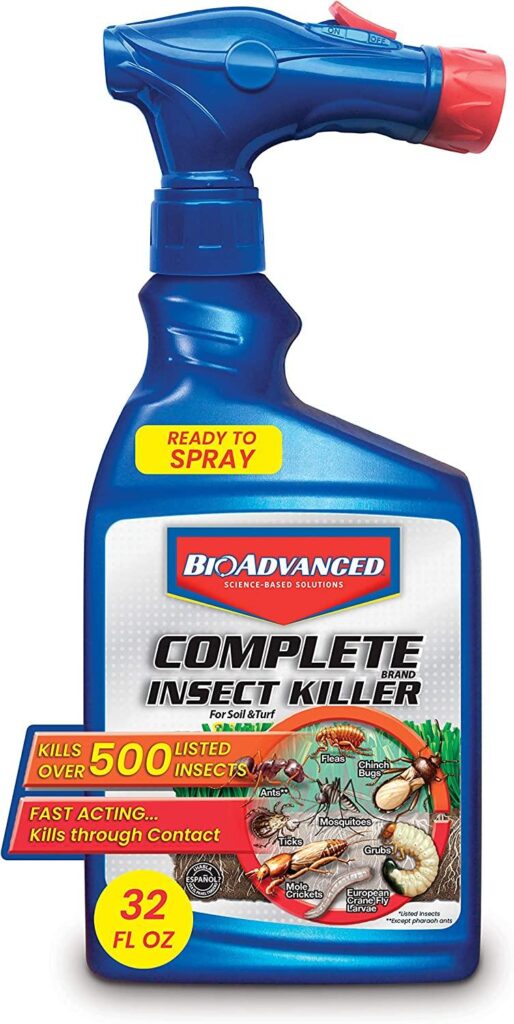
Kills surface insects, including grubs, ants, ticks, and more, in 24 hours.
Product Specs
Coverage Area: 5,000 sq. ft. Form: Liquid (Spray)
Organic: No Quantity: 30 ounces
Effective Against: Grubs, ticks, fleas, chinch bugs, ants, and more
Review
Bayer Crop Science Complete Insect Killer contains 1.47% imidacloprid as an active ingredient. This particular product from Bayer uses a two-step process that is very effective in managing grubs and a wide variety of other insects and pests.
The product claims to be effective against grub worms over the entire season after only a single application. It is also available in granular form, but the liquid spray is more commonly used, and it can cover an area of about 5000 q. ft.
The feedback from people is inconsistent; however, customers who successfully restored their flourishing lawn areas advocate employing this preventative strategy twice: spray once in the autumn and once at the start of the spring.
These active components of the grub killer comprise a contact insecticide that starts working right away and a systemic insecticide that defends the grass from the inside out.
Pros & Cons
| Pros | Cons |
| Dual insecticide formulaEconomicalIncluded application toolInstantly fatal on touchPerforms within a day | Product supply could be limited |
RELATED: Grubs In Lawn? Here Is How You Can Get Rid Of Them For Good!
Bayer Dylox 6.2 Granular White Grub Insecticide

Dylox 6.2 rescues and protects lawns and turf from grubs and certain other insects that feed on them.
Product Specs
Coverage Area: 10,000 sq. ft. Form: Granular
Organic: No Quantity: 30 pounds
Effective Against: Grubs, ticks, fleas, chinch bugs, ants, and more
Review
Dylox eliminated the grubs that were causing harm to my lawn almost immediately after I noticed signs of grub activity. There are no restrictions on the usage of this product by Dylox in terms of the types of grass species or locations. Also, the chemical does not persist in the environment for long.
Dylox is only harmful and active for a period of 48 hours. After being applied and watered according to the directions on the label, Dylox kills grubs and degrades in a short amount of time. Dylox should be soaked into the soil for at least one to one and a half hours for the most outstanding possible results.
This will ensure that the product penetrates the thatch layer and reaches the area where the grubs are eating. This product is capable of even creeping through thatch up to half an inch thick if it is adequately watered.
Pros & Cons
| Pros | Cons |
| Effective and rapidKills and deteriorates rapidlyNo limitations on locations or species | Relatively more costly than alternative options |
Sevin Concentrate Pest Control

Sevin Concentrate Pest Control can kill common household bugs such as ants, roaches, and spiders.
Product Specs
Coverage Area: 8,000 sq. ft. Form: Liquid
Organic: No Quantity: One gallon
Effective Against: Kills over 500 listed pests on vegetables, fruits, ornamentals, lawns
Review
Sevin is among the most effective general-purpose grub killers available for use on lawns. It has a substantially higher concentration of the active component carbaryl (22.5 percent). However, it is an upgrade from prior chemicals (Carbaryl), which were detrimental to honey bees and earthworms. After dissolving the concentrate in the water, you will have 86 gallons of ready-to-use treatment at your disposal.
Sevin concentrate works exceptionally well and fast. However, users should proceed with caution since “you have to be extremely careful because it is a dangerous material and you don’t want to get any on your hands,” as one of the users advised.
This concentrate is effective against up to five hundred different insect species that feed on fruit, vegetables, and flowers. However, it is not intended for usage inside.
Pros & Cons
| Pros | Cons |
| 8,000 sq. ft. are covered by one gallonResults will be visible within minutesEconomical | It can be pretty damaging on skin contact. |
Bayer Crop Science Season-Long Grub Control
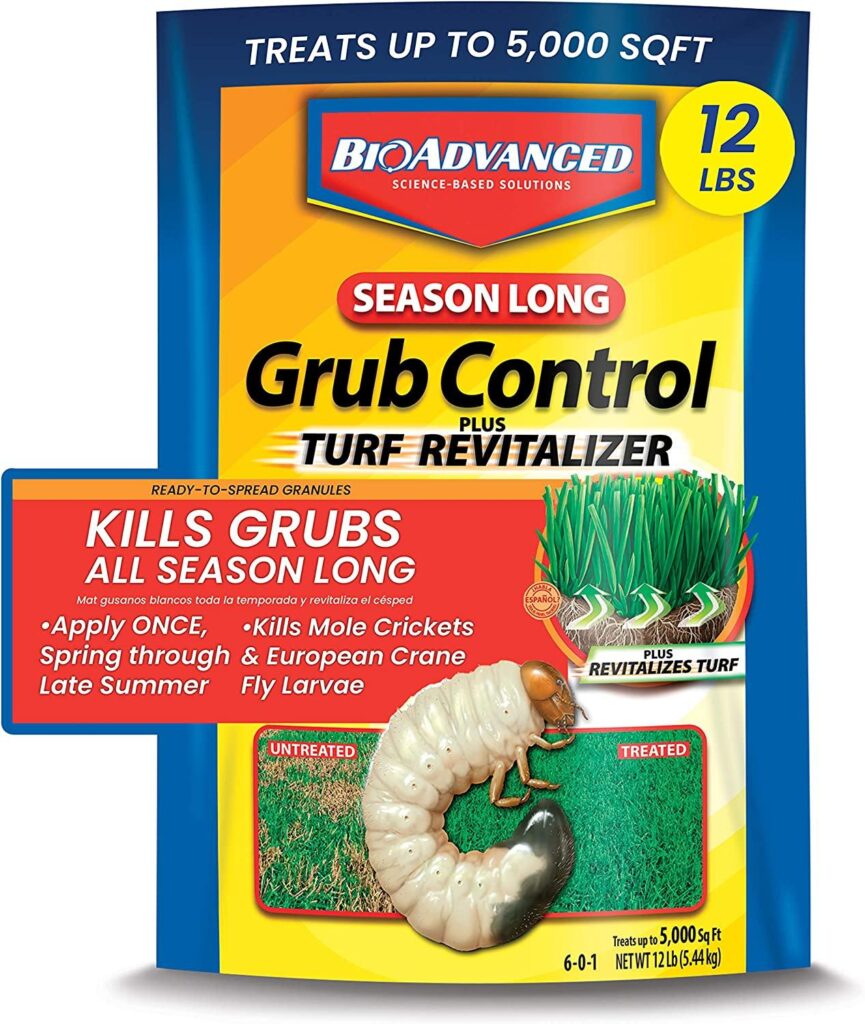
Its 2-in-1 formula kills grubs while also encouraging root & turf development.
Product Specs
Coverage Area: 5,000 sq. ft. Form: Granules
Organic: No Quantity: 10 pounds
Effective Against: Mole Crickets, Billbugs, in addition to grubs
Review
The Bayer Crop Science Season-Long Grub Control is a combination of fertilizer and systemic grub control that has been created to get rid of grubs and also help the grass heal at the same time. The application of systemic insecticide creates a barrier that prevents grubs from obtaining food throughout the entire season. In contrast, the application of the potassium and nitrogen plant food supplies promotes the nourishment of the grass that has been stressed in order to grow back healthy, lush, and strong.
Trichlorfon is an active component in Bayer’s 24-Hour Grub Killer Plus. You won’t have to wait for expert products to solve your armyworm or grub problem because you can get this at the store close to where you live. So, when you notice grubs on your lawn in the summer and observe that they are causing damage, it is time to apply grub control. And it is also the most appropriate time of year for grub control and eliminating grubs.
Pros & Cons
| Pros | Cons |
| Contains Nitrogen and potassium fertilizersSimple to locate in nearby hardware storesSystemic insecticideThe application is good for one year | PriceyProduct use might be restricted in some places |
Bonide – Insect & Grub Control
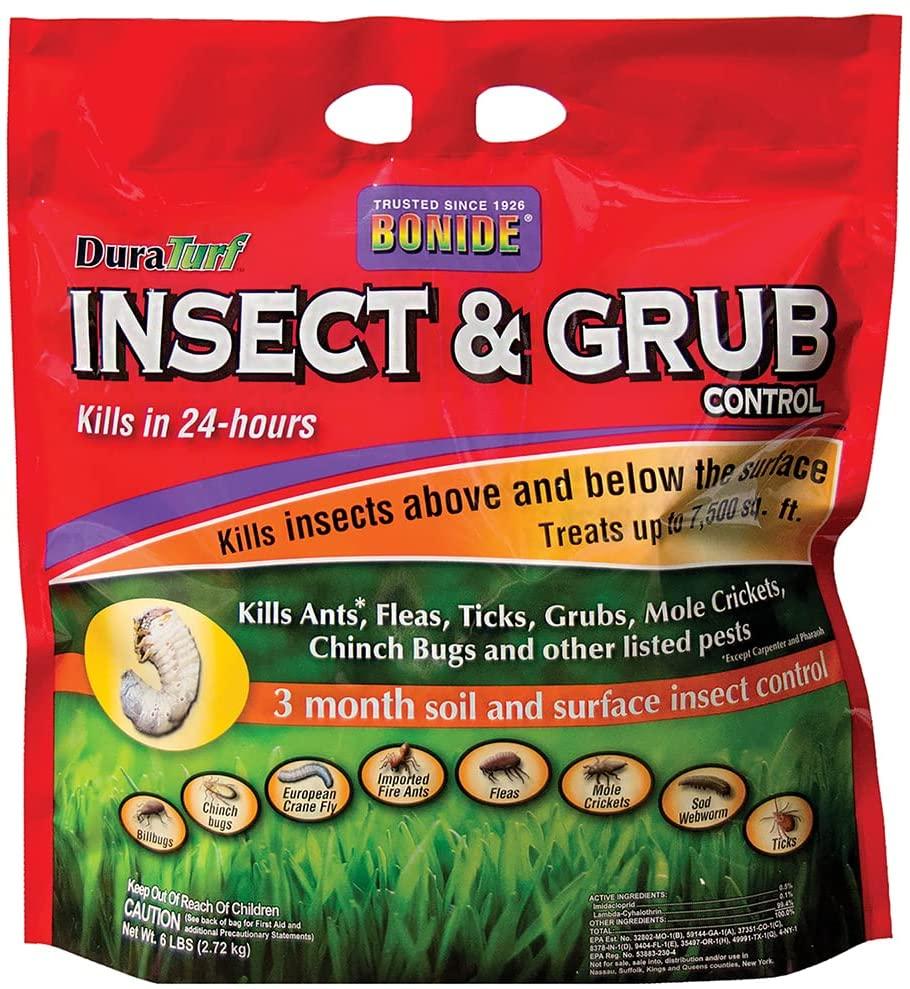
Combines the systemic action of Imidacloprid with the fast-acting insect control of Lambda-Cyhalothrin.
Product Specs
Coverage Area: 7,500 sq. ft. Form: Granules
Organic: No Quantity: 6 pounds
Effective Against: Grubs, billbugs, cutworms, ants, crickets, chinch bugs, and more
Review
Bonide Insect and Grub Control includes the power of a combination of contact and systemic pesticide to kill grubs and many other insects both above and below the ground.
Most of the pesticides included on this list are only effective when diluted with water. The solution sold by Bonide must also be watered. However, it eliminates a far more significant number of other pests that live above ground.
Keep this poisonous substance well out of reach of children and animals. Also, while you are applying the product, take precautions to protect your skin and face.
After it has been distributed, it takes effect almost immediately and eliminates grubs and other pests. You can reapply the insecticide every three months to ensure no new insects will emerge. You will need to distribute granules around the area you suspect has been overrun by grubs.
Pros & Cons
| Pros | Cons |
| Dynamic and effective componentsIt kills around 40 different types of tiny insectsThe price that doesn’t break the bankShows results within the first 24 hoursSimple in its applicationWorks both above and below ground | Can damage the skin on contactMay kill some helpful insects |
Bug Sales 50 Million Live Beneficial Nematodes – HB
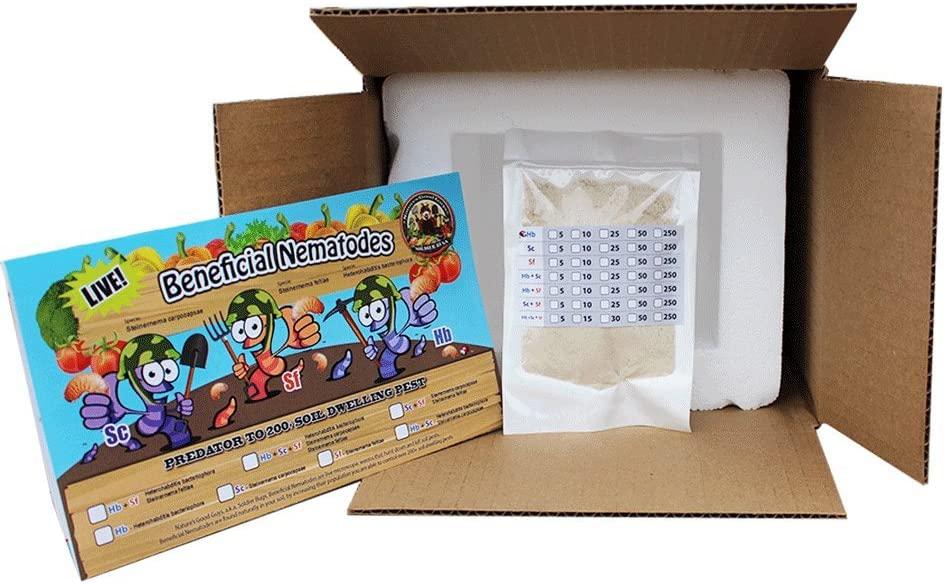
Each package contains Beneficial Nematodes species: Hb (Heterorhabditis bacteriophora).
Product Specs
Coverage Area: 20,000 sq. ft. Form: Granules
Organic: Yes Quantity: About five gallons
Effective Against: Grubs
Review
Beneficial nematodes are one of the most effective organic methods for controlling pests currently available, and their application is much simpler than you might think. These nematodes, which are parasitic on insects and grubs, get access to the bodies of soil-dwelling pests through openings in the skin, like the mouth or the anus.
Once inside, the nematodes release a bacterium that poisons the host pest and breaks down host tissue. Nematodes feed on the decomposing host tissue, and the host insect will perish within forty-eight hours. The active ingredient in this product is the species Heterorhabditis bacteriophora. To make use of this product, the powder should be mixed with between one and five gallons of cool water.
Next, apply the nematode powder to the grass using a pump-up sprayer, hose-end sprayer, or watering can. Nematodes can live for up to 18 months, equivalent to two full growing seasons. During this time, they will continue to control grubs.
Pros & Cons
| Pros | Cons |
| Rapid-acting formulationSimple to useSuitable for households that also contain children and animalsWorks for a period of up to 18 months | Product viability depends on storage conditions |
Ortho BugClear Lawn Insect Killer
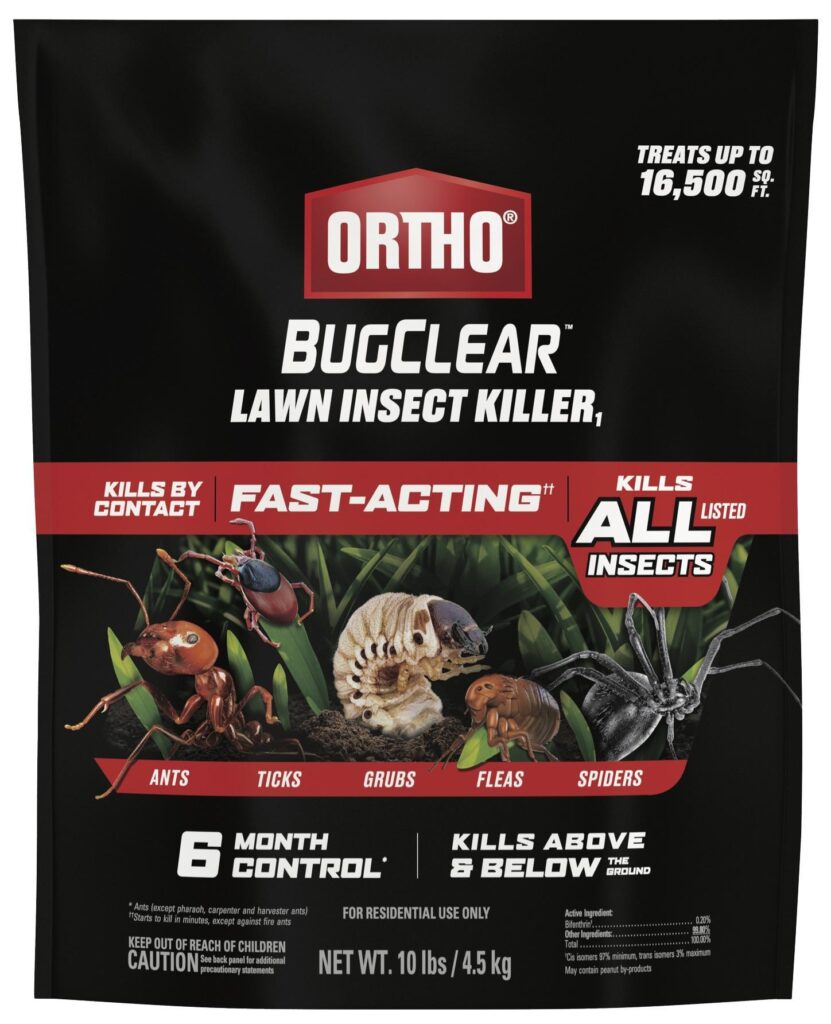
A broad-spectrum insecticide that kills a variety of insects.
Product Specs
Coverage Area: 10,000 sq. ft. Form: Granules
Organic: No Quantity: 10 pounds
Effective Against: Grubs, earwigs, spiders, stink bugs, mites, and more
Review
This fast-acting insecticide begins protecting against insects within minutes, and it kills on contact to provide protection against a number of pest insects in the yard. These insects include ants, fleas, spiders, ticks, armyworms, and grubs.
You can use it to defend your lawn, home perimeter, vegetable garden, ornamentals, and flower beds against annoying insects, killing them outside before they even had the chance to enter your home. The Ortho BugClear Lawn Insect Killer is a broad-spectrum insecticide that works both above and below the ground.
It can provide up to six months of ant control and three months of residual protection against ticks, beetles, spiders, and other specified insects. This product also forms a long-lasting barrier against other insects. Therefore, applying insecticide to your yard as early in the spring as possible, preferably before an infestation or as soon as insect activity or damage is first noticed, will produce the best effects.
Pros & Cons
| Pros | Cons |
| Appropriate for use on lawns and in gardensEffects last for up to three monthsInsecticides with a broad spectrum of activityIt works within hours or even minutesSeveral distinct kinds of applications | Not safe for homes with pets and children |
St. Gabriel Organics Milky Spore Powder
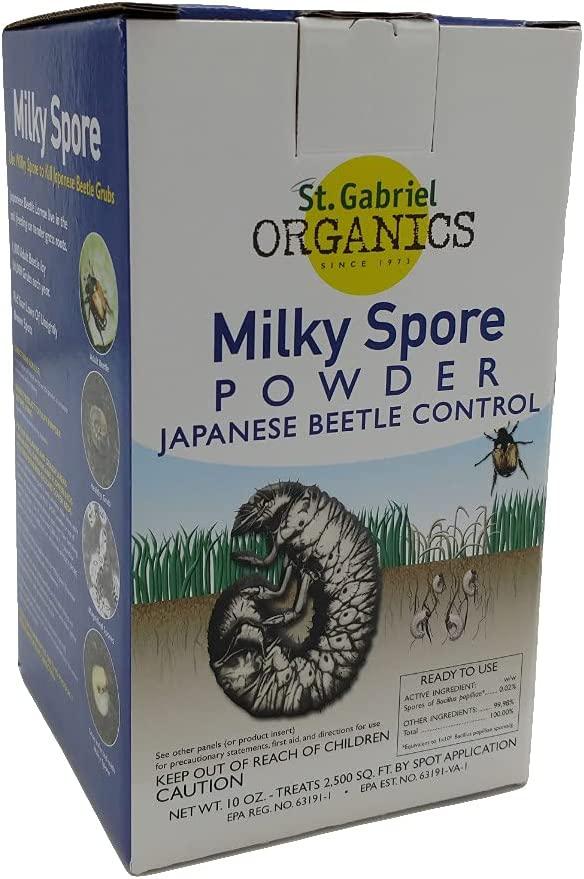
Milky spore powder is a microscopic bacteria that grubs before they can grow into ravenous adults.
Product Specs
Coverage Area: 2,500 sq. ft. Form: Granules
Organic: Yes Quantity: 10 ounces
Effective Against: Grubs of Japanese beetles
Review
Even though it has been around for a while, it is still regarded as one of the most effective strategies for managing the larvae of Japanese beetles. It works when the lawn grubs ingest the milky spore bacteria. After that, their body fluids change to a milky consistency, and they eventually die, which releases further bacterial spores into the soil.
The bacteria can stay dormant in the soil for anywhere between two and ten years. When applied to lawns, milky spores can be effective in controlling insects for up to three years in warmer climes, but the process can take even longer in areas with cooler temperatures. Milky spores can also be used in vegetable gardens without the risk of causing damage to the crops or contaminating them.
It is important to remember that milky spores will only benefit your grass if the problem is Japanese beetle grubs. The application of milky spores would be a waste of time and money if you were dealing with any other kind of illness or bug in your grass.
RELATED: What Is The Best Time To Apply Grub Control? A Comprehensive Guide
Pros & Cons
| Pros | Cons |
| Eliminates grubs while they are in the larval stage.InexpensiveMaintains its strength for up to ten years.Suitable for households that contain children & pets | Fewer quantity than comparable alternatives |
Final Thoughts
It’s heartbreaking to observe the results of grubs chewing at the roots of your grass after spending so much time and work on your lawn. Those unsightly dead patches in the lawn are unattractive, and voles and moles will come into your yard because of the grubs.
Fortunately, you can defend your lawn by applying a grub killer that has been specifically formulated. These insecticide treatments ensure that your grass looks wonderful all year long by eliminating grubs on contact.
When searching for a fantastic grub treatment for your lawn, the active component is the first thing that comes to mind to seek. However, that is not the end of the story. The ratings and reviews left by other customers will help you understand what to expect.
When shopping for grub control, there are a lot of different factors to take into account, and I’ve done my best to outline some of the most crucial ones here. I hope that this information will be both informative and helpful to you.
Frequently Asked Questions (FAQs)
What is the best product to kill grub worms?
Carbaryl and trichlorfon are both types of chemicals that are used as therapies, and they are both considered curative. They are chemicals with a short half-life lethal to all phases of the grub life cycle. Products containing active ingredients like chlorantraniliprole can also be used as a preventive soil treatment. These products are great at controlling large and active grub worm infestations in yards and gardens.
Which is better: GrubEx or Bayer grub control?
Both of these products are of extremely high quality and successfully eliminate a wide variety of typical grubs that might be living in the soil in your yard. Scotts GrubEx is an insecticide that kills grubs on touch and prevents their return, whereas Bayer Grub Killer Plus kills grubs on contact within twenty-four hours of application.
What is the best time to spray for grubs?
The best time to treat grubs is in the late summer or early fall because it is when the younger, smaller grubs are at their most vulnerable to nematodes. There is also typically a brief opportunity to apply the treatment in early spring. However, this is a much smaller window of opportunity, and it can be challenging to time it correctly.
What is the best natural grub killer?
Milky spore, neem oil, and nematodes are three of the most potent natural grub killers, and you can get these at most local nurseries. Sometimes simply spraying soapy water on your lawn and garden grubs is enough to get rid of them as it will smother them.
Does Sevin spray kill grubs?
The GardenTech brand provides a very efficient treatment that eliminates adult scarab beetles and white grubs upon contact and continues to provide protection for up to three months: White grubs and adult scarab beetles can be eradicated from lawns both below and above the soil line with the use of Sevin Insect Killer Spray.
Sources For Further Reading
How to choose and when to apply grub control products for your lawn – Michigan State University, Department of Entomology
Managing White Grubs In Turfgrass – Purdue University Extension Service
How do I treat for grubs on my lawn?- University of New Hampshire Extension Service
Editor’s Recommendations
White Fuzzy Jumping Bug on Plants: How to Get Rid of Them?
What Is Eating My Broccoli Leaves & How To Fix It | Causes & Solutions







